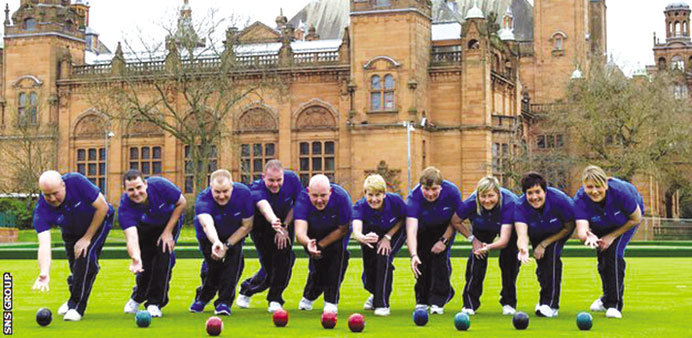The Commonwealth Games lawn bowling programme is being staged in the shadow of Glasgow’s Kelvingrove Art Gallery.
The only thing that will stop these guys is thunder,” says one of the press assistants, looking out at the multitude of matches being played across four bowling greens, as rain clouds appear overhead.
And indeed, as the heavens opened, the bowlers stolidly continue to play, their faces pictures of concentration.
The lawn bowls at the Commonwealth Games 2014 are being played on the picturesque greens at Kelvingrove park, which also give spectators a pleasant view of the grand red stone art gallery and museum behind them.
“It does look calm, doesn’t it, but it’s very competitive,” says Scotland women’s skip Margaret Letham. “(You’ve got to) keep your focus, just keep your focus on each shot that you play, don’t look ahead to the next end or the next game. Try not to get upset and unruffled.”
“Our opponents, we’ve known them for 20 years, playing against each other numerous times,” says Herman Scholtz, who won gold for South Africa in the para-sport mixed pairs B2/B3. “We’re friends off the bowling green, but on the green it’s a battle.”
The sport is fairly easily explained, but highly tactical. Players have to throw a small ball, called a jack, down the green. They then take turns to throw their bowls, aiming to get them as near as possible. Matches can last for several hours and comprise of around 15 to 18 “ends”.
Lawn bowling is also one of the only events at the Games where some of the tiniest nations take on their larger counterparts.
On the first day of competition, Norfolk Island (population just over 2,000), managed to beat South Africa in the women’s fours, while Northern Ireland was beaten by Fiji.
“You get some strange results in bowls, you can play the best bowls of your life and still lose,” notes Letham.
Unfortunately, it also has something of a reputation as an old codger’s sport.
Indeed, many of the spectators are elderly and wheelchairs vie with prams at Kelingrove’s pushchair park.
It is possibly the only sport to have regulations on walking aids (the base must be rubber-tipped and at least 76 millimetres across).
On Saturday, 75-year-old Bruce Jones became the first athlete over 70 to win a gold medal—in the para-sport mixed pairs—since Manchester 2002.
But the bowlers themselves are keen to emphasize that the sport is attracting younger players.
“I think there’s more young people coming in because our dress is changing,” says Letham. “We’re moving away from the greys and the long, white trousers, especially when we’re playing at this level. We’re playing with shorts and colourful t-shirts.”
And indeed, there is a mix of all age groups at Kelvingrove. The average age of the blonde and tanned Australian women’s team is 27.
“We joke about that,” says Tony Sherwill, a journalist travelling with them. “It’s only because of grandma, Karen Murphy. She’s 39.”



